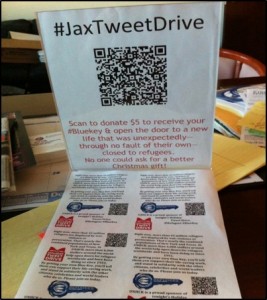 As more and more brands jump on the influencer marketing bandwagon, how they structure influencer programs and communications is becoming increasingly important.
As more and more brands jump on the influencer marketing bandwagon, how they structure influencer programs and communications is becoming increasingly important.
Here are some guidelines.
1. Make your ask as solid as possible before you go out with it.
What exactly is it you want influencers to do? Create content? Share it? Show up somewhere?
It’s usually at least some combination of the first two, but if you’re not clear about what it is you’re looking for, your influencer marketing program will be off to a rocky start.
For example, a former client that we work with on and off wanted some advice on an influencer program. So we suggested things like:
- short-form content (e.g. tweets, Instagram posts, etc.)
- long-form content (e.g. blog posts, maybe even building to a blog community)
- in-person elements, such as travel to an event location
- visual content of the influencers themselves, such as photos for commercial or non-commercial use
… and so on.
I bet you could come up with some very creative ideas – those are just a few basic ideas as an example.
What we were very clear about, though, was that all this needed to be figured out before approaching the influencers.
Whether or not you’re compensating influencers, you want to be very clear about what your brand’s expectation is, what their commitment is, and the parameters for their involvement.
2. An influencer program and a content bazaar are two different things.
This is an actual pitch I received two days ago:
“I’m reaching out because you have an active following on social media and we’re currently looking for influencers like you to post engaging content on your social media accounts that would be of interest to your followers. Through our platform, you can choose from a wide range of different campaigns, keeping your followers engaged and diversifying your social media accounts…
Oh and did I mention we’re going to pay you?
That’s right: Each time one of your followers views the content through your post, you get paid.”
I saved the email for two reasons:
- I figured it was great for teaching (like this blog post!); and
- I might – might – actually go through their process just to experience it (and then write about it after).
But I don’t need to have signed up to know one thing: this company is not engaging in true influencer marketing.
It’s simply building a bazaar (did you know that word comes from the Persian language?) where it will parade its “influencers” in front of potential advertisers.
Image: Juan ignacio Tapia via Unsplash, CC Zero
The latter will be dazzled by high follower counts, and shell out some bucks, a Tiddly Portion of which will go to the “influencers.”
Who will – and again, I’m guessing here, but I’ve been around a while so it’s an educated guess – really start pushing their content to get more views and, therefore, more of the T.P.
If this is the way you want to go? Totally fine, it’s a free world (at least, in most places).
But don’t fool yourself that this is “influencer” outreach. It’s not.
3. Even if you pay influencers, you cannot expect to influence them.
Yes, more and more influencers expect to be compensated for participating in such programs.
And more and more brands realize they may have to factor influencer compensation into their plans.
However… and this is a big one… you canNOT expect that, just because you are compensating an influencer for participating in your program, they will write/say/do exactly what you want them to.
What you are providing compensation for is:
a) The influencer’s time and expertise. Their expertise is (should be) the whole reason you approached them. And depending on how involved your program is, they could spend quite a bit of time on it… so that’s fair.
b) The potential to reach and engage with their audience, which should be aligned with your target audience.
But in no way does any of this mean you can dictate the tone or quality of their content.
If you’re doing your job right, you shouldn’t have too much to worry about… because you should be working with influencers with whom you’ve built a relationship, about which you’re transparent, and so on.
So while the odds should be in your favor, you cannot and should not expect any guarantees from them as to the nature of their content.
Note: this is completely different to outlining the structure of the program they’re signing onto (#1 above). That is totally fine. You just can’t ask for guarantees that their coverage will be positive, etc.
The client I mentioned in #1 above? When we were very clear that we could not guarantee the actual tone of content… they pulled back.
And we said, OK. Because that’s just not the way we operate.
4. Designate a point person for influencer communications.
Depending on the size and scope of your program, this could be one person, or perhaps it’s a small team.
But you will find it much easier to manage your influencer relationships if they know whom to contact for questions, when they need help, and so on.
If you’re on the agency side, and managing an influencer program for a brand, you might even have two POCs; one for the influencers (or more, if you’re working with a large number of them), and one for the client.
Help your influencers by managing communications with and for them; it will go a long way in them not being bothered with irrelevant details or half-baked emails.
5. Know which flagpole to run approvals up most quickly.
If you’re doing a good job with your influencers, you might very well find they start coming up with great ideas. Because once they’re invested in your brand, that’s what will happen.
If you have an archaic approval system within your company (or in your agency-brand communications), these ideas might be DOA. And that might end up being how your influencer program goes too. Because there is nothing more disheartening than ideas that don’t go anywhere.
So put your approval processes in place ahead of time, and refine them as they go along.
What happens if you’re coming up on a big milestone and your influencers have a great idea to generate some attention? That’s what happened during the Blue Key campaign, for example, before the first #bluekey tweetathon.
That was a Champion (i.e. influencer) -generated idea… and it was a great one! And they came up with it a couple of weeks before World Refugee Day that year.
If we’d had to go through copious rounds of approvals, the tweetathon would never have happened, because the Champions would have lost interest.
But since we didn’t, we were able to set it up in a matter of days (literally!) and it was an incredible success. We had no clue how successful it would be, but that’s a whole other story.

6. Make sure your crisis communications plan accounts for influencers gone wild.
Hopefully this is something you’ll never have to deal with.
But what if one/more of your influencers goes rogue? Mildly or manically?
What if they start to become bigger than your brand, by virtue of association with your brand… and it goes to their head?
What if your influencers don’t go rogue, but just happen to be in the path of an accident, catastrophe or disaster while being associated with your brand?
Do you know how you’ll handle it? If you don’t, you better start thinking about it.
I’m not trying to alarm you into lawyering up, but you do need to predict and prepare for such eventualities… and then hope you never have to actually implement that plan.
7. Be transparent. Disclose, disclose, disclose!
I was in two minds as to whether to include this or not. Because transparency and disclosures should be built into everything we do, including influencer programs.
But I don’t want you guys thinking I don’t think it’s important… so it’s #7.
For a really excellent read on this subject, check out Kerry O’Shea Gorgone’s recent post over at {grow}. There’s just no point in my regurgitating Kerry’s already excellent advice… so please do make sure you read it.
I will, however, reiterate it: no matter how you structure and manage your programs and relationships with influencers, disclosures are a must. No ifs, ands, or buts.
These, to me, are the 7 pillars around which solid influencer marketing programs are structured (and again, transparency and disclosures are given). Are you already using all of these pillars? Did I miss any?
Let me know what you think, you know what to do!

![[EVENT]: PR Hacks for Small Biz (online)](https://shonaliburke.com/wp-content/uploads/2021/06/FB-Ad-1200x800-01-01-01-Copy-500x383.jpeg)








[…] means that independent business owners like Rajean and Sohini could be some of your most effective influencers … if you let […]
[…] While most brands fall somewhere in between these two extremes, there are brands at both ends of the spectrum. The majority of brands are aware of the influencers who their buyers know, like and trust, but identifying these influencers is only the first step. The next piece of the puzzle is to establish relationships with them and integrate influencers into your current marketing strategy. […]
[…] 5. 7 Pillars of Solid Influencer Marketing Programs […]
Thanks for the shout out, Shonali!
But of course! I just wish I’d beaten you to the punch, LOL. ;)